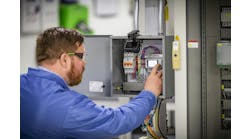We determine motor efficiency as the ratio of mechanical power output to electrical power input. When we look at power output, we can determine this by speed and torque, and when we mention power input, we determine this by voltage and current. Because energy is wasted during electrical to mechanical conversion in various forms, such as heat and friction, mechanical power output is always less than electrical power intake. The design of an electric motor seeks to reduce these losses in order to enhance efficiency.
Electric motors are critical components in many industrial processes, accounting for a large amount of energy required in a facility. The cost of downtime associated with failing motors can be significant, given their vital significance for industrial processes.
Also read: Smarter drives mean more useful motors
One of the most critical duties that maintenance technicians and engineers undertake every day is ensuring that motors are efficient and reliable. Motors are a key target for producing savings and preserving profitability in industry because they consume such a large share of energy.
And, although the traditional procedure for monitoring the performance and efficiency of electric motors is well-established, this can be difficult to use in operational settings. In reality, many motor benchmarks need a full system shutdown, which can be expensive.
Benchmarking electric motors can show a loss of performance, allowing corrective action to be scheduled and reducing unwanted downtime and repair costs. In the case of a failure, benchmarking results may provide a glimpse into the underlying cause. The benchmarking procedure should proceed for the length of the motor's life. It should ideally start with controlled factory tests and then be incorporated into the motor's installation, use, service and repair. The level and extent of benchmarking should really be determined by the expense of benchmarking, the expense of repair, the cost of decreased productivity and the consequences of a premature failure.
When correctly applied, a well-designed motor-maintenance program can be characterized as preventive or predictive. Another option is reactive maintenance. Inspection cycles are influenced by the type of motor and the running conditions. Motors need regular maintenance to operate effectively.
In a preventive, or time-based, maintenance program, motors should really be serviced and evaluated at minimum every six months. Only after that can a motor's life and efficiency be sustained. The aim of preventive motor maintenance is to minimize operational problems and assure that the motor continues to work properly. Preventive maintenance is often a planned part of system maintenance.
The goal of predictive, or condition-based, motor maintenance is to ensure that the correct type of service is done at the right time. To establish these two factors, it is necessary to regularly monitor the motor operation and thereby detect problems before they occur.
The main objective of reactive motor maintenance is to replace and fix the motor when it malfunctions. Reactive maintenance, also called as machine failure or breakdown, does not involve regular service or inspection.
Let’s look at some issues you can find with motors that can cause trouble with efficiency and life. First, let us look at motor ventilation. If the motor is installed and operated in an unventilated area, the temperature of the motor may increase to harmful levels, degrading the insulation and bearing lubrication and causing the motor to fail.
Debris and dust can block airflow openings. As a consequence, wiping debris away on a routine basis is essential for keeping the motor from overheating. Even if motors are protected, it is important to install them in areas with continuous airflow to prevent damage to insulation and bearings from extreme temperatures. The greater a motor's longevity, the cooler it operates. As a consequence, the fan cover and cooling fin should continuously be as clear as possible.
Second, let's look at loose connections. All connections must be tightened and torqued to the standards. Fuses, cable connectors, contactors and circuit breakers are well-known for having loose connections, and they should be closely investigated on a routine basis.
Finally let’s look at undervoltage and overvoltage. Undervoltage and overvoltage damage the stator insulation of the motor. Undervoltage raises the insulation's temperature. Motors run hotter, slide more, create less torque, run at a poorer full-load efficiency and could have a shorter life at lower voltages. In most cases, overvoltage conditions can be handled by induction motors. But extreme overvoltage can result in turn-to-turn, phase-to-phase or phase-to-ground short circuits. The phases or the phases and the frame are shorted out in that situation.
A well-maintained motor will be more efficient and have a longer lifespan, also allowing for the reduction of energy consumption. There is more to do than just installing and allowing motors to run when it comes to efficiency.





